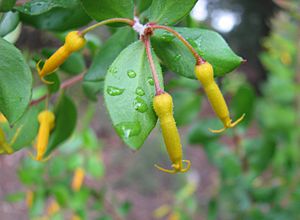Myrtle geebung facts for kids
Quick facts for kids Myrtle geebung |
|
|---|---|
 |
|
| In Maranoa Gardens | |
| Scientific classification | |
| Genus: |
Persoonia
|
| Species: |
myrtilloides
|
| Synonyms | |
|
|
The Myrtle geebung (scientific name: Persoonia myrtilloides) is a special plant found only in New South Wales, Australia. It's part of the Proteaceae family, which includes many unique Australian plants like banksias and grevilleas. This plant is usually a shrub that stands upright or spreads out. It has pretty yellow flowers and leaves that look like an ellipse or an egg.
What Does Myrtle Geebung Look Like?
The Myrtle geebung is a shrub that can grow from about half a meter to two and a half meters tall. Its young branches are a bit hairy. The leaves are shaped like an ellipse or an egg. They are usually between 12 and 50 millimeters long and 4 to 30 millimeters wide. When they are young, the leaves are also hairy.
The bright yellow flowers grow in groups of up to forty. They are arranged along a stem called a rachis, which can be up to 170 millimeters long. After the plant flowers, this stem often grows into a leafy shoot. Each flower sits on a small stalk called a pedicel, which is 2 to 10 millimeters long. There is usually a leaf at the base of each flower.
The flower parts, called tepals, are yellow and 9 to 12 millimeters long. They are hairy on the outside. Myrtle geebung flowers bloom from December to April. The fruit is a green, plum-like fruit called a drupe, which often has a purple tint.
How Myrtle Geebung Got Its Name
The scientific name Persoonia myrtilloides was first officially described in 1827. Two scientists, Josef August Schultes and his son Julius Hermann Schultes, published the description. They used notes from an earlier, unpublished description by Franz Sieber.
There are actually two slightly different types, or subspecies, of Myrtle geebung. These are called P. myrtilloides subsp. myrtilloides and P. myrtilloides subsp. cunninghamii. The main difference between them is the shape and size of their leaves.
- P. myrtilloides subsp. cunninghamii has narrow, ellipse-shaped leaves. These leaves are 20 to 50 millimeters long and 4 to 12 millimeters wide.
- P. myrtilloides subsp. myrtilloides has broader, egg-shaped or lance-shaped leaves. These leaves are 12 to 38 millimeters long and 6 to 30 millimeters wide.
Sometimes, the Myrtle geebung can even mix with other types of geebung plants, like the needle geebung (P. acerosa), P. levis, and P. recedens. This happens when these different species grow close together.
Where Myrtle Geebung Lives
Myrtle geebung grows in the Blue Mountains area of New South Wales. You can find it from Wentworth Falls northwards to Capertee. The subspecies cunninghamii is found in the Wollemi National Park and near the Cudgegong River.
Both subspecies grow as understory plants. This means they grow beneath the taller trees in open forests. They prefer soils that are based on sandstone.
The myrtilloides subspecies often grows with trees like Sydney peppermint (Eucalyptus piperita). It also grows with other shrubs like old man banksia (Banksia serrata) and mountain devil (Lambertia formosa). You can also find it in heath areas, which are open lands with low-growing shrubs.
The cunninghamii subspecies grows with different trees. These include scribbly gum species (Eucalyptus rossii) and rough-barked apple (Angophora floribunda).
Animals like currawongs, kangaroos, and possums are thought to eat the fruit of the Myrtle geebung. When they do, they help spread the seeds in their droppings. Many different insects also visit the flowers to feed. These include various types of bees.

